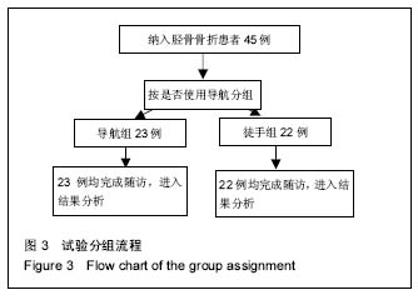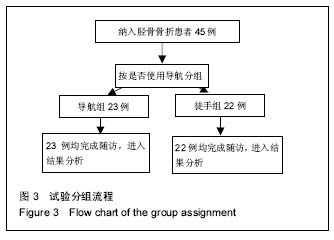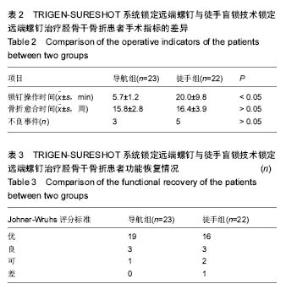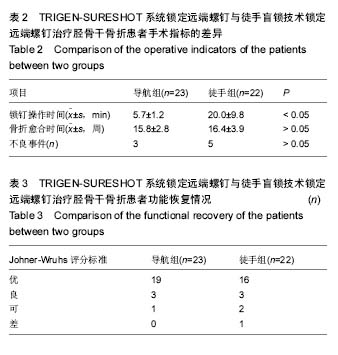Chinese Journal of Tissue Engineering Research ›› 2017, Vol. 21 ›› Issue (27): 4342-4347.doi: 10.3969/j.issn.2095-4344.2017.27.014
Previous Articles Next Articles
A new navigation system for distal locking of tibial intramedullary nail
Li Jun, Zhan Jun-feng, Xu Xin-zhong, Shi Zhi-gang, Fu Yu, Han Bing, Wang Yin-sheng, Zhou Yun, Jing Jue-hua
- Department of Orthopedics, the Second Hospital of Anhui Medical University, Hefei 230601, Anhui Province, China
-
Online:2017-09-28Published:2017-10-24 -
About author:Li Jun, M.D., Attending physician, Master’s supervisor, Department of Orthopedics, the Second Hospital of Anhui Medical University, Hefei 230601, Anhui Province, China -
Supported by:the General Project of National Natural Science Foundation of China, No. 81671204; the Natural Science Foundation of Anhui Province for the Youth, No. 1708085QH221; the Independent Innovation Project of Hefei, No. YW201608080006; the Chinese Medicine Research Project of Health and Family Planning Commission of Anhui Province, No. 2016zy92; the Key Technology Research & Development Program of Anhui Province, No. 1501041149
CLC Number:
Cite this article
Li Jun, Zhan Jun-feng, Xu Xin-zhong, Shi Zhi-gang, Fu Yu, Han Bing, Wang Yin-sheng, Zhou Yun, Jing Jue-hua . A new navigation system for distal locking of tibial intramedullary nail [J]. Chinese Journal of Tissue Engineering Research, 2017, 21(27): 4342-4347.
share this article
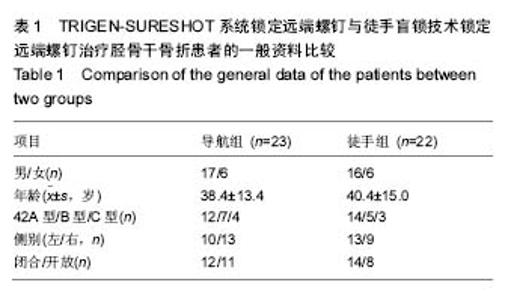
2.2 基线资料 2组患者性别比、年龄、骨折类型等一般资料差异无显著性意义(P > 0.05;表1),具有可比性。 2.3 髓内钉远端锁钉情况 导航组远端锁钉时间显著少于徒手组(P < 0.05),见表2。导航组的46枚远端锁钉均一次性置入成功,一次性成功率100%,徒手组的44枚远端 锁钉中,15枚一次性置入成功,一次性成功率34%,差异有显著性意义(P < 0.05)。 2.4 骨折愈合与功能恢复情况 导航组患者骨折愈合时间略小于徒手组,差异无显著性意义(P > 0.05),见表2。末次随访时,依照Johner-Wruhs评分标准对胫骨功能进行评估,导航组患者优良率为96%(22/23),而徒手组优良率为86%(19/22),两组功能恢复情况比较,差异无显著性意义(P > 0.05),见表3。 "
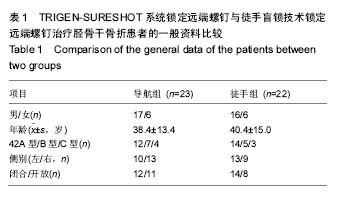
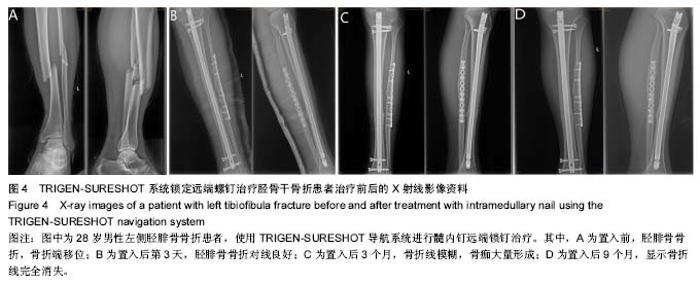
2.5 典型病例 患者,男,28岁,车祸致左侧胫腓骨闭合性骨折,AO/ASIF分型42A2型,入院后予跟骨牵引,消肿后行左侧腓骨切开复位钛板内固定和胫骨髓内钉固定,使用TRIGEN-SURESHOT导航系统进行髓内钉远端锁钉,远端锁钉操作时间4.0 min。置入后14周骨折愈合,切口愈合良好,末次随访的Johner-Wruhs评分为优,其影像学资料见图4。 2.6 不良事件 导航组发生浅表感染1例,加强换药和延长使用抗生素,最终愈合;发生膝关节疼痛2例,在骨折愈合取出髓内钉后疼痛消失。徒手组发生浅表感染2例,加强换药后愈合;发生膝关节疼痛2例,在取出髓内钉后疼痛消失;发生骨折愈合延迟1例,动力化之后愈合满意。两组均未发生主钉松动、退钉、变形或断裂;未发生深部感染和异位骨化。两组不良事件发生情况差异无显著性意义(P > 0.05),见表2。"
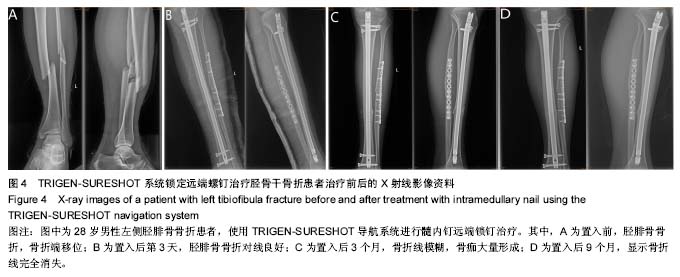
| [1] Newman SD, Mauffrey CP, Krikler S. Distal metadiaphyseal tibial fractures. Injury. 2011;42(10):975-984.[2] Ramos L, Bertrand ML, Benitez-Parejo N, et al. How many distal bolts should be used in unreamed intramedullary nailing for diaphyseal tibial fractures? Injury. 2012;43 Suppl 2: S59-62. [3] Li Y, Liu L, Tang X, et al. Comparison of low, multidirectional locked nailing and plating in the treatment of distal tibial metadiaphyseal fractures. Int Orthop. 2012;36(7):1457-1462. [4] Singer RW, Kellam JF. Open tibial diaphyseal fractures. Results of unreamed locked intramedullary nailing. Clin Orthop Relat Res. 1995;(315):114-118.[5] Keating JF, O'Brien PJ, Blachut PA, et al. Locking intramedullary nailing with and without reaming for open fractures of the tibial shaft. A prospective, randomized study. J Bone Joint Surg Am. 1997;79(3):334-341.[6] Ludwig M, Hymes RA, Schulman J, et al. Intramedullary Nailing of Open Tibial Fractures: Provisional Plate Fixation. Orthopedics. 2016;39(5):e931-936. [7] Fu B. Locked META intramedullary nailing fixation for tibial fractures via a suprapatellar approach. Indian J Orthop. 2016;50(3):283-289. [8] Saied A, Ostovar M, Mousavi AA, et al. Comparison of intramedullary nail and plating in treatment of diaphyseal tibial fractures with intact fibulae: A randomized controlled trial. Indian J Orthop. 2016;50(3):277-282. [9] 王磊.扩髓与非扩髓髓内钉治疗成人闭合性胫骨干骨折的Meta分析[D].兰州:兰州大学,2012.[10] 代黎明.髓内钉与钢板内固定治疗胫骨远端关节外骨折的Meta分析[J].医药,2015(2):164-165.[11] Foda AA. Radiation-Independent Distal Locking Screw Insertion Using Dual Nail Insertion Handle: Is it a Reliable Method? J Orthop Trauma Rehabil. 2017;22:30-33.[12] 韩天宇,梁娜,刘欣伟,等.电磁导航系统与徒手锁定在胫骨髓内钉远端锁定应用中的对比研究[J].创伤外科杂志,2016,18(3): 146-148.[13] Zhou Z, Zhou X, Shan B, et al. Electromagnetic Navigation in Distal Locking of Long Diaphyseal Interlocking Intramedullary Nailing. J Coll Physicians Surg Pak. 2016;26(12):975-979.[14] 陈孝平,汪建平.外科学[M].8版.北京:人民卫生出版社,2013:635.[15] 侯靖钊,张秋林,包洪卫,等.髓内钉结合阻挡螺钉修复胫骨远段骨折[J].中国组织工程研究,2016,20(31):4616-4622.[16] Johner R, Wruhs O. Classification of tibial shaft fractures and correlation with results after rigid internal fixation. Clin Orthop Relat Res. 1983;(178):7-25.[17] Whatling GM, Nokes LD. Literature review of current techniques for the insertion of distal screws into intramedullary locking nails. Injury. 2006;37(2):109-119. [18] Hashemi-Nejad A, Garlick N, Goddard NJ. A simple jig to ease the insertion of distal screws in intramedullary locking nails. Injury. 1994;25(6):407-408.[19] 魏小华,廖志峰.多压杆胫骨髓内钉远端锁定装置的临床研究[J].实用骨科杂志,2017,23(4):356-358.[20] Anastopoulos G. Distal Locking with Mechanical Jig (Author’s Own Technique)//Practice of Intramedullary Locked Nails. Springer Berlin Heidelberg, 2006:271-274.[21] 王健军,雷厉,刘予豪,等.磁力导航交锁髓内钉内固定治疗股骨干骨折34例[J].实用中医药杂志,2015,31(12):1160-1161.[22] Ikem IC, Ogunlusi JD, Ine HR. Achieving interlocking nails without using an image intensifier. Int Orthop. 2007;31(4): 487-490.[23] 何启新,廖穗波,黄建军.磁力导航髓内钉与传统髓内钉治疗股骨干骨折的疗效比较[J].中国矫形外科杂志,2016,24(4):372-375.[24] Ikem IC, Esan O, Orimolade EA, et al. External jig in the placement of distal interlocking screws. Nigerian J Orthop Trauma. 2011;10(1):759-761.[25] Mandal S, Coleman N. An easy method of distal locking in exchange tibial nailing. Injury Extra. 2005;36(7):287-288.[26] Boraiah S, Barker JU, Lorich D. Efficacy of an aiming device for the placement of distal interlocking screws in trochanteric fixation nailing. Arch Orthop Trauma Surg. 2009;129(9): 1177-1182.[27] 谢洋,陈小强,王金华,等.磁力导航交锁髓内钉在治疗胫骨干骨折中的应用[J].临床骨科杂志,2010,13(3):307-309.[28] Uzoigwe CE, Middleton RG. Occupational radiation exposure and pregnancy in orthopaedics. J Bone Joint Surg Br. 2012; 94(1):23-27. [29] Mahajan A, Samuel S, Saran AK, et al. Occupational radiation exposure from C arm fluoroscopy during common orthopaedic surgical procedures and its prevention. J Clin Diagn Res. 2015;9(3):RC01-04. [30] Antonini G, Stuflesser W, Crippa C, et al. A distal-lock electromagnetic targeting device for intramedullary nailing: Suggestions and clinical experience. Chin J Traumatol. 2016; 19(6):358-361.[31] 周震涛,周晓中,周海斌,等.电磁导航交锁髓内钉内固定在长骨干骨折的应用[J].江苏医药,2015,41(9):1103-1104.[32] Maqungo S, Horn A, Bernstein B, et al. Distal interlocking screw placement in the femur: free-hand versus electromagnetic assisted technique (sureshot). J Orthop Trauma. 2014;28(12):e281-283.[33] 刘晓强,王洪伟,李铠湘,等.无X线暴露下股骨交锁髓内钉远端锁钉置入的新方法[J].中国骨与关节损伤杂志, 2016,31(12): 1307-1308.[34] Rueger JM, Rücker AH, Hoffmann M. Suprapatellar approach to tibial medullary nailing with electromagnetic field-guided distal locking. Unfallchirurg. 2015;118(4):302-310. [35] 史萌,张磊,周琳,等.SURES HOT导航技术与徒手技术股骨髓内钉远端锁钉效能比较[J].国际骨科学杂志,2016,37(3):194-197.[36] Chan DS, Burris RB, Erdogan M, et al. The insertion of intramedullary nail locking screws without fluoroscopy: a faster and safer technique. J Orthop Trauma. 2013;27(7): 363-366.[37] 陈永佳,张佳田,潘知常,等.电磁导航交锁髓内钉在胫骨干骨折中的应用[J].中国骨与关节损伤杂志,2017,32(4):407-408.[38] 潘宏,陶岳峰,郑毅,等.电磁导航远端瞄准系统和交锁髓内钉治疗股骨干骨折的效果[J].上海医学,2015(9):725-727,741.[39] Stathopoulos I, Karampinas P, Evangelopoulos DS, et al. Radiation-free distal locking of intramedullary nails: evaluation of a new electromagnetic computer-assisted guidance system. Injury. 2013;44(6):872-875. [40] Moreschini O, Petrucci V, Cannata R. Insertion of distal locking screws of tibial intramedullary nails: a comparison between the free-hand technique and the SURESHOT™ Distal Targeting System. Injury. 2014;45(2):405-407.[41] 左康康,覃巍,郭青,等.电磁导航交锁髓内钉远端锁钉技术治疗股骨干骨折的初步应用[J].中国修复重建外科杂志, 2014(10): 1204-1207. |
| [1] | Yao Xiaoling, Peng Jiancheng, Xu Yuerong, Yang Zhidong, Zhang Shuncong. Variable-angle zero-notch anterior interbody fusion system in the treatment of cervical spondylotic myelopathy: 30-month follow-up [J]. Chinese Journal of Tissue Engineering Research, 2022, 26(9): 1377-1382. |
| [2] | Zhang Jinglin, Leng Min, Zhu Boheng, Wang Hong. Mechanism and application of stem cell-derived exosomes in promoting diabetic wound healing [J]. Chinese Journal of Tissue Engineering Research, 2022, 26(7): 1113-1118. |
| [3] | An Weizheng, He Xiao, Ren Shuai, Liu Jianyu. Potential of muscle-derived stem cells in peripheral nerve regeneration [J]. Chinese Journal of Tissue Engineering Research, 2022, 26(7): 1130-1136. |
| [4] | He Yunying, Li Lingjie, Zhang Shuqi, Li Yuzhou, Yang Sheng, Ji Ping. Method of constructing cell spheroids based on agarose and polyacrylic molds [J]. Chinese Journal of Tissue Engineering Research, 2022, 26(4): 553-559. |
| [5] | He Guanyu, Xu Baoshan, Du Lilong, Zhang Tongxing, Huo Zhenxin, Shen Li. Biomimetic orientated microchannel annulus fibrosus scaffold constructed by silk fibroin [J]. Chinese Journal of Tissue Engineering Research, 2022, 26(4): 560-566. |
| [6] | Chen Xiaoxu, Luo Yaxin, Bi Haoran, Yang Kun. Preparation and application of acellular scaffold in tissue engineering and regenerative medicine [J]. Chinese Journal of Tissue Engineering Research, 2022, 26(4): 591-596. |
| [7] | Kang Kunlong, Wang Xintao. Research hotspot of biological scaffold materials promoting osteogenic differentiation of bone marrow mesenchymal stem cells [J]. Chinese Journal of Tissue Engineering Research, 2022, 26(4): 597-603. |
| [8] | Shen Jiahua, Fu Yong. Application of graphene-based nanomaterials in stem cells [J]. Chinese Journal of Tissue Engineering Research, 2022, 26(4): 604-609. |
| [9] | Zhang Tong, Cai Jinchi, Yuan Zhifa, Zhao Haiyan, Han Xingwen, Wang Wenji. Hyaluronic acid-based composite hydrogel in cartilage injury caused by osteoarthritis: application and mechanism [J]. Chinese Journal of Tissue Engineering Research, 2022, 26(4): 617-625. |
| [10] | Li Hui, Chen Lianglong. Application and characteristics of bone graft materials in the treatment of spinal tuberculosis [J]. Chinese Journal of Tissue Engineering Research, 2022, 26(4): 626-630. |
| [11] | Gao Cangjian, Yang Zhen, Liu Shuyun, Li Hao, Fu Liwei, Zhao Tianyuan, Chen Wei, Liao Zhiyao, Li Pinxue, Sui Xiang, Guo Quanyi. Electrospinning for rotator cuff repair [J]. Chinese Journal of Tissue Engineering Research, 2022, 26(4): 637-642. |
| [12] | Guan Jian, Jia Yanfei, Zhang Baoxin , Zhao Guozhong. Application of 4D bioprinting in tissue engineering [J]. Chinese Journal of Tissue Engineering Research, 2022, 26(3): 446-455. |
| [13] | Liu Zemin, Lü Xin. Application of intramedullary nailing in the treatment of long tubular bone fractures of the extremities: reaming and non-reaming [J]. Chinese Journal of Tissue Engineering Research, 2022, 26(3): 461-467. |
| [14] | Yang Ruijia, Jiang Lingkai, Dong Zhengquan, Wang Yunfei, Ma Zhou, Cong Linlin, Guo Yanjing, Gao Yangyang, Li Pengcui. Open reduction and internal fixation versus circular external fixation for tibial plateau fractures: a meta-analysis [J]. Chinese Journal of Tissue Engineering Research, 2022, 26(3): 480-486. |
| [15] | Liu Jiali, Suo Hairui, Yang Han, Wang Ling, Xu Mingen. Influence of lay-down angles on mechanical properties of three-dimensional printed polycaprolactone scaffolds [J]. Chinese Journal of Tissue Engineering Research, 2022, 10(16): 2612-2617. |
| Viewed | ||||||
|
Full text |
|
|||||
|
Abstract |
|
|||||
